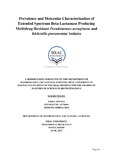Prevalence and molecular characterization of extended spectrum Beta-Lactamase producing multidrug-resistant Pseudomonas aeruginosa and Klebsiella pneumoniae isolates
Abstract
The discovery of antibiotics has revolutionized health care worldwide. However, the life-saving role of antibiotics is threatened by the emergence of antibiotic- resistant ‘superbugs’. With the emergence of antibiotic resistance and rise of ‘superbug’ bacteria has begun to produce Extended Spectrum Beta Lactamase (ESBL).
In this study, twenty-five Klebsiella pneumoniae isolates were collected from patients with respiratory tract infection whereas twenty-five Pseudomonas aeruginosa isolates were collected from both respiratory tracts infected patients and burn patients. The study was also performed to estimate the prevalence of ESBL producing Multidrug Drug Resistant K. pneumoniae and P. aeruginosa isolates. The ESBL producing isolates were further investigated by six primers (blaIMP, blaVIM-2, blaNDM-1, blaTEM, blaCTX-M and blaCLR) to confirm the presence of specific antibiotic resistant genes.
In this study, isolates of P. aeruginosa from wound were found more multidrug-resistant than those from sputum samples. The percentage of resistance to oxacillin, aztreonam, ceftazidime, amikacin, and ampicillin was 100% for pus samples. Regarding the P. aeruginosa isolates from the sputum samples were 100% resistant to all of the aminoglycosides (ampicillin and oxacillin) but resistance percentage was less for all the other antibiotics. P. aeruginosa (n=25) and K. pneumoniae (n=25), both the organisms were highly resistant to oxacillin and ampicillin (100%) whereas least resistance was found for imipenem and meropenem. This study showed that 88% of isolates of K pneumonia and 100% of isolates of P. aeruginosa were ESBL producers. Out of the 44 ESBL producer organisms, five had blaNDM-1 gene, one had the blaMCR gene and one had CTX-M gene. One of the samples showed resistant gene for both blaNDM-1 and blaCLR whereas one sample showed resistant gene for both blaNDM-1 and blaCTX-M. All the seven organisms were P. aeruginosa isolates from pus of burn patients. Only one sample showed resistance against imipenem. This proves that carbapenems are effective antibiotics for ESBL treatment.
This study helps us to understand the need for more precaution in use of antibiotics and the alarming rate of resistance seen in ICU burn patients and respiratory tract infected patients. Future studies can be focused on sequencing of NDM-1, MCR and CTX-M gene.

